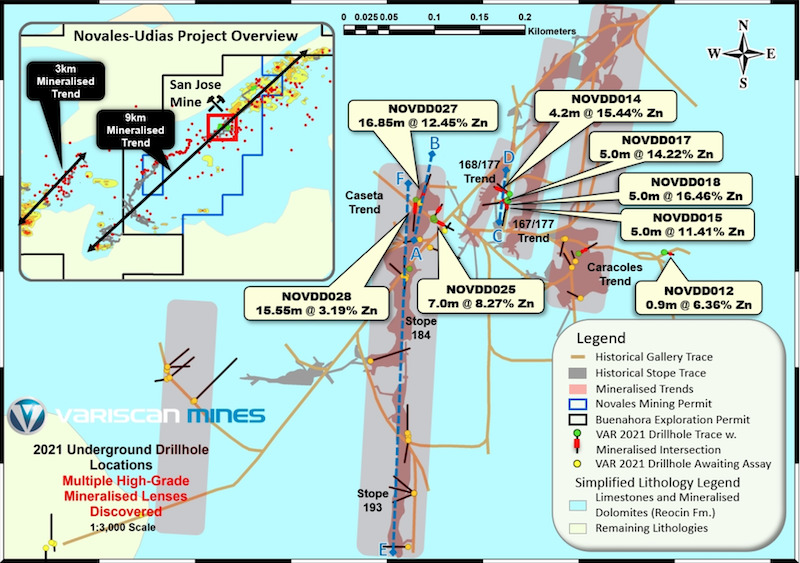Major zinc-lead discovery by Variscan at San Jose

Pic: Bloomberg Creative / Bloomberg Creative Photos via Getty Images
Variscan Mines has intersected high-grade zinc mineralisation above and below the Central Zone stopes of its historic San Jose mine in Spain.
The discovery of two trends – labelled La Caseta and 168-177 – is an exciting development for Variscan (ASX:VAR), as it confirms the presence of multiple mineralised lenses below areas of known underground mining activity.
The La Caseta Trend is a new laterally extensive, high-grade mineralised lens beneath the main gallery level at the Central Zone.
Intersections here include 16.9m at 12.5% zinc and 2.5% lead and 15.6m at 3.2% zinc and 0.3% lead, with mineralisation remaining open.
Above the gallery level, a further intersect of 7m at 8.3% zinc and 0.1% lead was hit.
A further 400m of length testing the southward extent over the lower lens has now been drilled, and Variscan said the majority of holes exhibited positive visual zinc mineralisation.
Assay results for a further 20 drillholes are expected shortly.
The 168-177 Trend comprises mineralisation below and above the main gallery level, with intersects below including 5m at 14.2% zinc and 4.3% lead and 5m at 11.4% zinc and 2.8% lead.
High grade mineralisation above the gallery level includes 5m at 16.5% zinc and 1.7% lead and 4.2m at 15.4% zinc and 5% lead.
The remainder of the mine is mostly untested at depth, a factor Variscan believes provides potential for further discoveries of high-grade mineralised lenses.
Managing director and CEO Stewart Dickson said the discovery could have significant positive ramifications for the company.
“The discovery of new high-grade mineralised lenses below the main gallery is a major development for Variscan,” he said.
“It suggests significant potential for discovering additional lenses throughout the San Jose Mine as the remainder of the mine has had barely any drilling to test for lower lying lenses. In aggregate, that could provide considerable scale and tonnage potential.
“Additionally, it reinforces the conceptual model of San Jose as a multi-layered orebody, consisting of multiple vertically stacked, sub-horizontal high-grade mineralised lenses of variable thickness and geometry, separated by intervals of dolostone.
“This is typical of a classical MVT style deposit and similar to the nearby, world class Reocin Mine; this further illustrates the quality of this deposit.”
Dickson said follow up work on the lower lens beneath the La Caseta Trend would begin promptly.

Next steps
Variscan has outlined a series of key activities moving forward to continue its momentum at San Jose.
These include receiving and interpreting assay results from the drilling at San Jose’s Central Zone; submitting assay results from drilling at San Jose’s South West Zone; mapping and sampling of surface drill targets over its Buenahora license area, and surface drilling here in Q2/Q3 of this year pending approval of applications; and mapping and sampling of targets over its Guarjarez project in Castilla La Mancha.
The San Jose mine is part of the Novales-Udias project located in the Basque-Cantabrian Basin 30km southwest of the regional capital Santander.
The project is centred around the former producing Novales underground mine with a large surrounding area of exploration opportunities.
Areas identified by Variscan of interest include a number of satellite underground and surface workings and areas of zinc anomalism identified in recent and historic geochemical surveys.
The company has also delineated a significant 9km mineralised trend and a sub-parallel 3km trend from contemporary and historical data across both the Buenahora exploration and Novales mining permits.
This article was developed in collaboration with Variscan Mines, a Stockhead advertiser at the time of publishing.
This article does not constitute financial product advice. You should consider obtaining independent advice before making any financial decisions.
Related Topics
UNLOCK INSIGHTS
Discover the untold stories of emerging ASX stocks.
Daily news and expert analysis, it's free to subscribe.
By proceeding, you confirm you understand that we handle personal information in accordance with our Privacy Policy.








